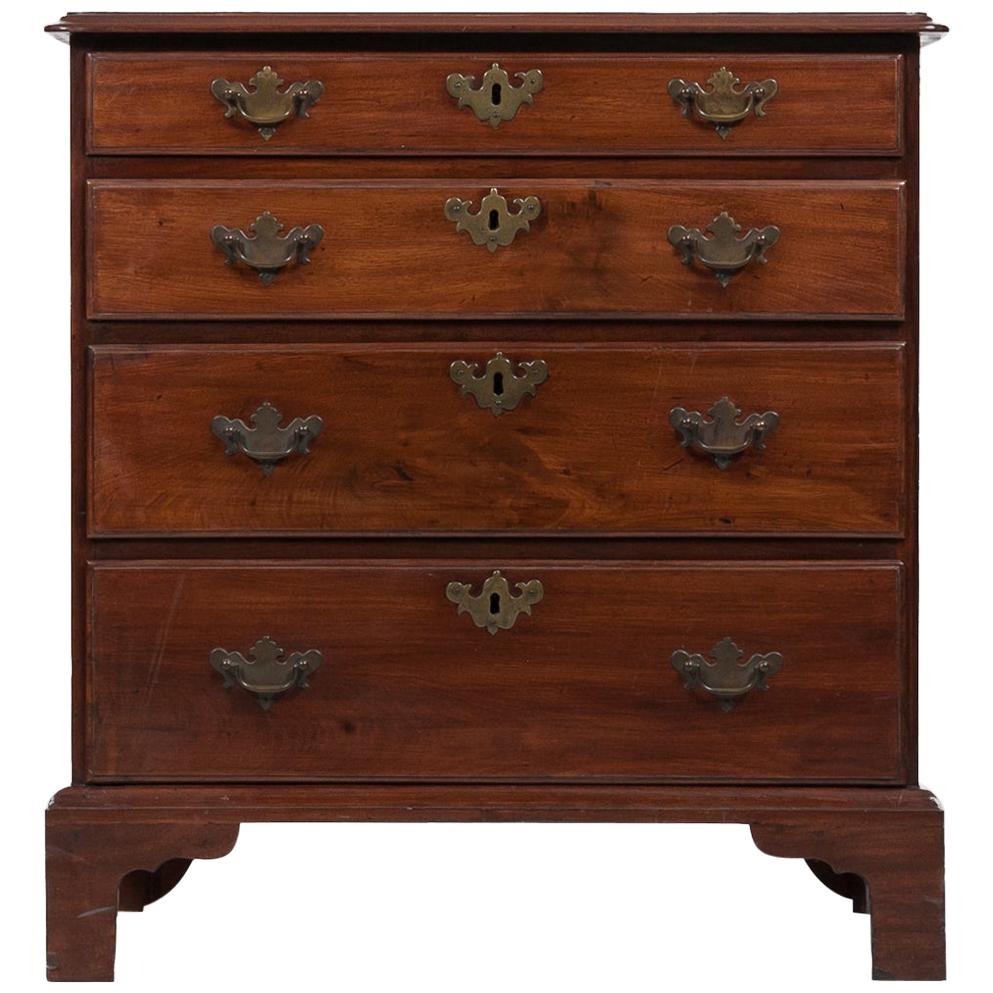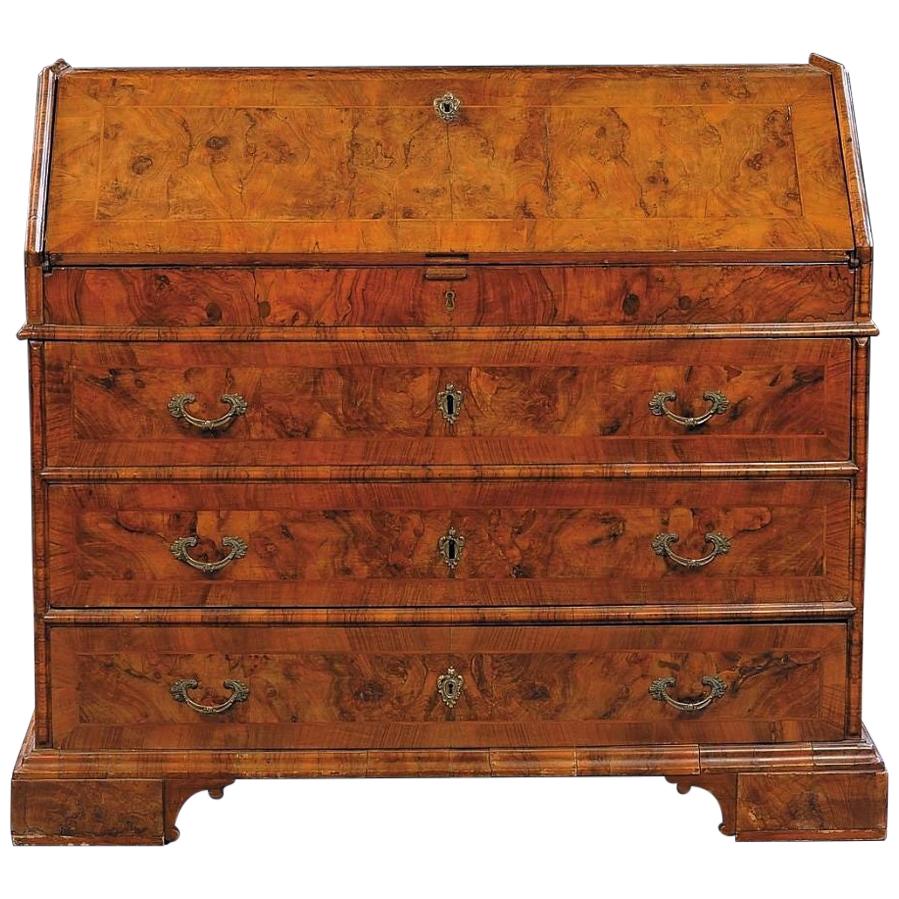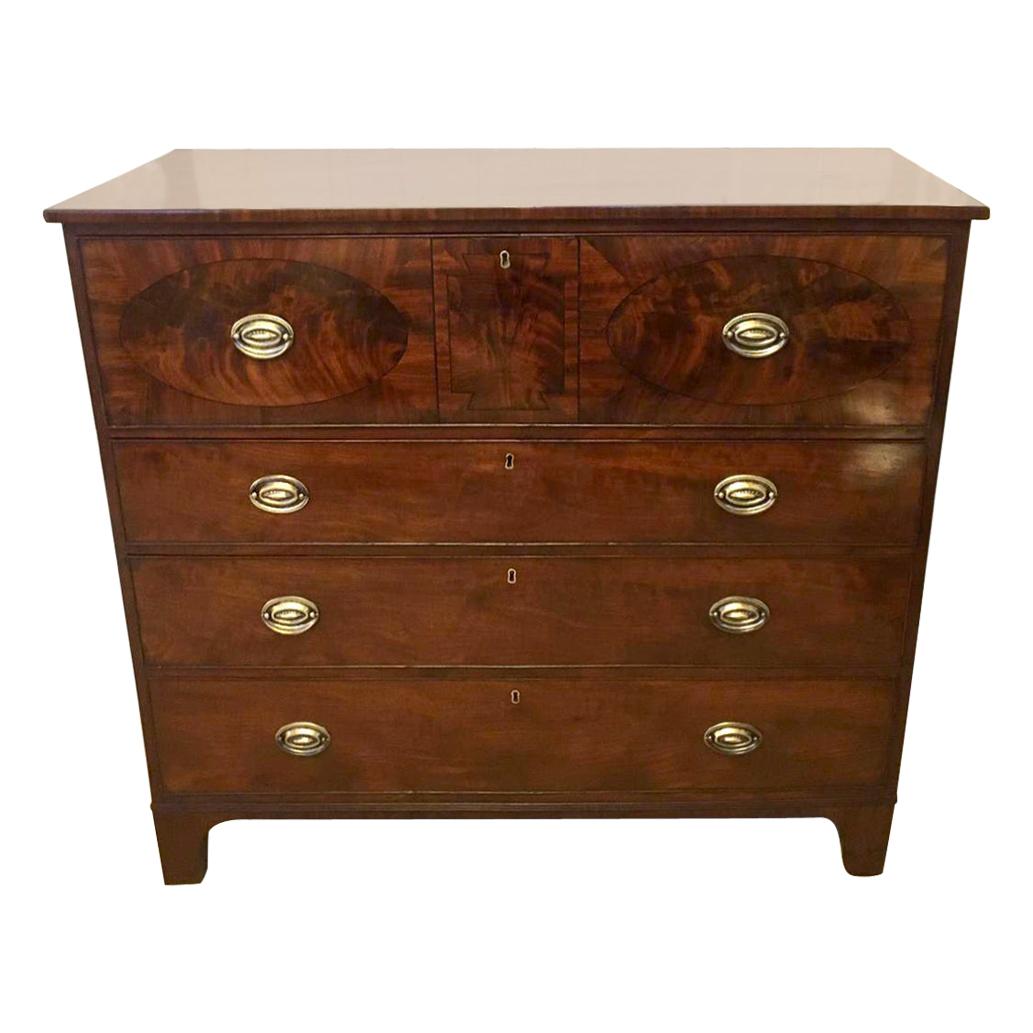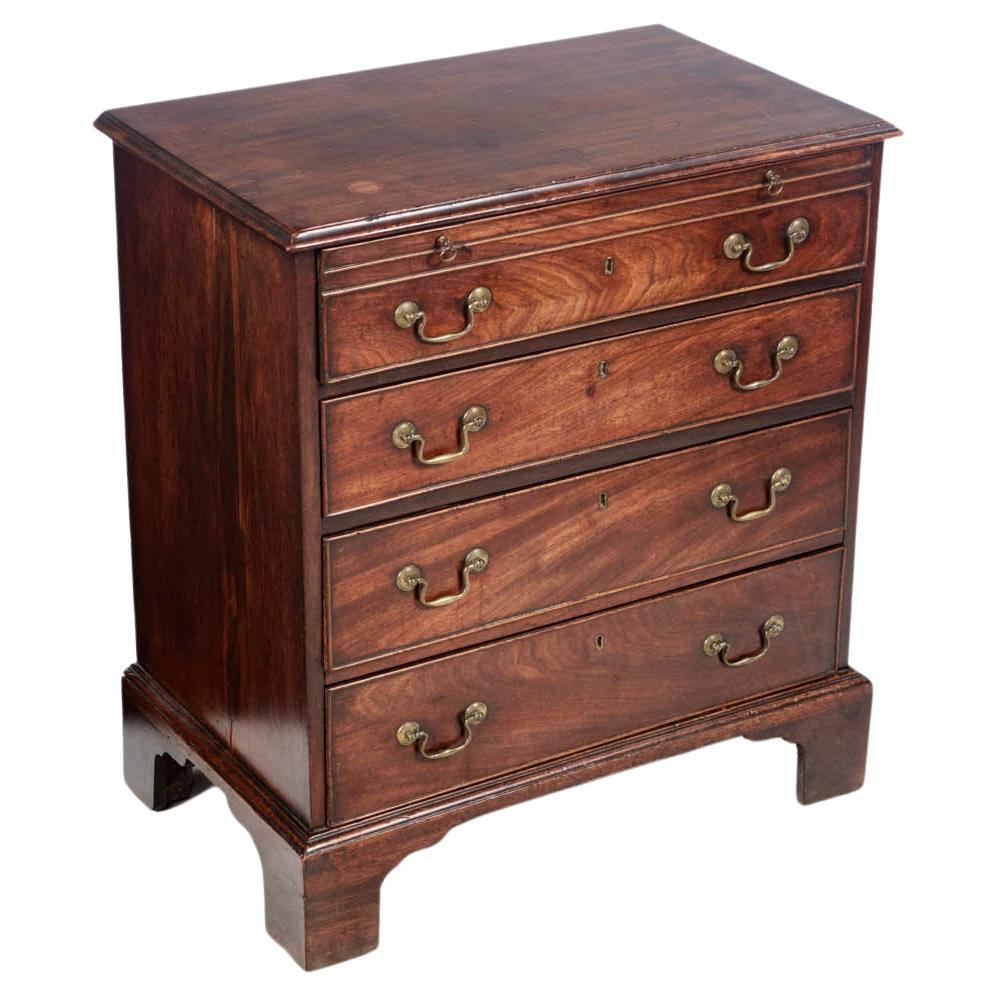Items Similar to Early 18th Century George I Figured Walnut Bachelors Chest, C.1720-1730
Want more images or videos?
Request additional images or videos from the seller
1 of 10
Early 18th Century George I Figured Walnut Bachelors Chest, C.1720-1730
About the Item
A fine and rare early 18th-century compact George I figured walnut bachelors chest
The quarter veneered feather and crossbanded top opens on original hinges to reveal a veneered interior of six book-matched sections similarly feather and crossbanded, above a pair of lopers, one long, two short and two graduating oak lined drawers each beautifully veneered, feather banded and cock-beeded, raised on a moulded base and original bracket feet.
The gilded ring pull handles and oval escutcheons appear to be original.
It should be noted that the chest is of fantastic colour and patination.
- Dimensions:Height: 29.53 in (75 cm)Width: 27.56 in (70 cm)Depth: 13.78 in (35 cm)
- Style:George I (Of the Period)
- Materials and Techniques:
- Place of Origin:
- Period:
- Date of Manufacture:1720-1730
- Condition:Wear consistent with age and use. The chest is in wonderful original condition in line with age and use.
- Seller Location:Oxfordshire, GB
- Reference Number:1stDibs: LU4936226161672
About the Seller
5.0
Recognized Seller
These prestigious sellers are industry leaders and represent the highest echelon for item quality and design.
1stDibs seller since 2019
20 sales on 1stDibs
Associations
LAPADA - The Association of Arts & Antiques Dealers
- ShippingRetrieving quote...Ships From: Faringdon , United Kingdom
- Return PolicyA return for this item may be initiated within 14 days of delivery.
More From This SellerView All
- A Unique Early 18th Century Diminutive George I Figured Walnut Bachelors TableLocated in Oxfordshire, United KingdomA Unique Early 18th Century Diminutive George I Figured Walnut Bachelors Table, Circa 1720-1730 The table is of very rare diminutive proportions raised...Category
Antique Early 18th Century English George I Card Tables and Tea Tables
MaterialsWalnut
- A Fine 18th Century George II Figured Walnut Chest on Chest or Tallboy, 1740Located in Oxfordshire, United KingdomA Fine 18th Century George II Figured Walnut Chest on Chest or Tallboy, Circa 1740. England. In two parts divided by a cross grain moulding the reeded upper section consists of a c...Category
Antique 17th Century English George II Cabinets
MaterialsOak, Walnut, Burl
- Early 18th Century George I Figured Walnut Bureau BookcaseBy Peter MillerLocated in Oxfordshire, United KingdomA superb and exceptionally well proportioned early 18th century figured walnut ‘pagoda topped’ double dome bureau bookcase, circa 1720 England. The upper section is surmounted with what is believed to be the original solid walnut finials and soft bevelled mirror plates, opening to a removal bank of walnut veneered and feather banded drawers, cantered by pigeonholes below two shelves. Candle slides are neatly stowed below the bookcase doors to reflect the light. To the moulded bureau, the fall opens to reveal pigeonholes, long and short asymmetric drawers each beautifully veneered in figured walnut and feather banded, cantered by a cupboard door which neatly conceals an open compartment and drawer. Below the fall, two short and two long graduating oak lined drawers are each book-matched in superb sections of hand-cut figured walnut veneers over bun feet. It should be noted that this exceptional desk and bookcase, is not only of the finest cuts of figured walnut veneer but exquisitely made at the pinnacle of design which had gradually evolved predominantly in London, during the late 17thand early 18thcentury. The actual description 'desk-and-bookcase' appears to be first recorded in the accounts of the Royal cabinet-maker Gerrit Jensen (fl.1680-d.1715) who supplied several for the Royal Household from 1710 (Bowett, op. cit.), and another described as 'a walnut writing desk, the top for books and patons and glass in the doors asked' for the 5th Earl of Salisbury, Hatfield House. Another maker of this form of desk was the London cabinet-maker John Gumley (1691-1727) who advertised in Richard Steele's Lover on April 24 1714 that he 'hath taken for a Ware-house, and furnished all the upper part of the New Exchange in the Strand' continuing with an extensive list of his stock including 'Desks and Bookcases.' In 1714 he supplied one of these in walnut to James 1st Duke of Montrose for the sum of £11. Russian cabinetwork of this period was strongly influenced by Tsar Peter I return to Russia after his studies in London. He subsequently sent twenty-four cabinetmakers who were working in Amsterdam to London to train as furniture makers. One of these cabinetmakers named Fedor Martynov made furniture for the Empress Anna Ioannovna. Martynovs drawings are almost identical to the present piece. Literature Mallett’s Great English Furniture, London: Bullfinch Press 1991, p.248, fig 287, by Lanto Synge, English Furniture 1660-1714 From Charles II to Queen Anne, by Dr Adam Bowett, Woodbridge: Antique Collector’s Club, 2002 Chapter 7 Case Furniture 1689–1714 pp.221-223 fig. 7:53 A walnut bureau bookcase of the same form and period sold from the private collection of Patricia Kluge...Category
Antique Early 18th Century British George I Bookcases
MaterialsWalnut
- 18th Century George III Mahogany Bachelors Chest by Philip Bell, LondonLocated in Oxfordshire, United KingdomAn extremely rare 18th century George III mahogany bachelors chest with brushing slide, by Philip Bell. Circa 1758-1774. London England. The moulded mahogany top sits above a scratch moulded brushing slide over four oak lined graduated cock-beaded drawers retaining original gilt brass swan neck handles and locks, raised on original bracket feet. The Maker Philip Bell, St Paul's Churchyard, London (fl. 1758–74) Successor to Elizabeth Bell and almost certainly her son. His father was probably Henry Bell...Category
Antique 18th Century English Chippendale Commodes and Chests of Drawers
MaterialsBrass
- 18th Century George II Figured Walnut Console Table, Sienna Brocatelle MarbleLocated in Oxfordshire, United KingdomA fine George II figured walnut console table with Sienna Brocatelle marble top, circa 1740. England The moulded Sienna Brocatelle marble sits over a figured walnut moulded cavetto frieze, raised on eared solid walnut legs terminating on shaped pad feet. Lovely rich colour with well-patinated surfaces. Provenance Private Chicago collection Mallet Antiques...Category
Antique Early 18th Century British George I Side Tables
MaterialsMarble
- Rare 18th Century George I Gilt Gesso Mirror, circa 1720Located in Oxfordshire, United KingdomA fine and rare early 18th century George I Gilt Gesso pier or console mirror, circa 1720-1730 The period bevelled mirror plate sits within an upright lobed moulded gilt frame flanked by cascading carved foliage below a broken swan neck pediment, surmounted with a foliate carved armorial...Category
Antique 18th Century English George I Pier Mirrors and Console Mirrors
MaterialsGesso, Mirror, Giltwood
You May Also Like
- 18th Century George II Bachelor ChestLocated in Dublin 8, IE18th century George II figured Cuban mahogany bachelor chest of excellent compact proportions retaining excellent patina. The rectangular figur...Category
Antique 18th Century Irish George II Commodes and Chests of Drawers
MaterialsMahogany
- George I Secretary Bureau or Escritoire of Figured Walnut from the 18th CenturyLocated in Austin, TXA fine English period George I secretary bureau escritoire or scriptor of figured patinated walnut from the 18th century featuring original s...Category
Antique 18th Century English George I Secretaires
MaterialsMetal, Brass
- 18th Century, Italian Walnut Wood Bureau Chest of DrawerLocated in IT18th century, Italian walnut wood bureau chest of drawer This bureau chest of drawer was made in Emilia, in Italy, at the beginning of the 18th century. The structure is entirely paved in the precious wood essence of walnut and walnut root. The upper portion has a door that opens to the fore to show inside a compartment divided into six drawers. There is also a secret, which is fulfilled by running the support plan. The front then has three drawers equipped with door locks and handles in chiseled bronze. The cabinet rests on a band that front is interrupted to create two feet, a feature that gives elegance and lightness to the compositional line. The walnut veneer is applied playing on the different designs of the wood and this gives the furniture a refined chromatic effect of great decorative. This flap is suitable to be inserted in different environments of your home is combined with antique furniture in...Category
Antique Early 18th Century Italian Louis XV Commodes and Chests of Drawers
MaterialsBronze
- Antique Early 19th Century George III Inlaid Mahogany Secretaire ChestLocated in Suffolk, GBAntique early 19th century George III inlaid mahogany secretaire having a splendid mahogany top with top faux drawer having beautifully crafted inlaid oval panels which drops and ope...Category
Antique Early 19th Century English George III Secretaires
MaterialsBrass
- 18th Century George III Mahogany Bachelor’s ChestLocated in Dublin 8, IE18th century George III Mahogany Bachelor’s chest. Petit in size, the plain top is surrounded by ogee molding. The four graduated, cockbeaded d...Category
Antique 18th Century English George III Commodes and Chests of Drawers
MaterialsBrass
- Outstanding Early 18th Century English George I SecretaryLocated in Dallas, TXPresenting a stunningly gorgeous and outstanding early 18th century English George I Secretary. This is one of the finest old English Secretary’s...Category
Antique Early 18th Century English George I Secretaires
MaterialsMahogany, Satinwood, Walnut
Recently Viewed
View AllMore Ways To Browse
Georgian Early
Early Georgian Furniture
Small Chest Of Drawers
French Louis Commode
Louis Xvi Marble Top
Antique Wood Veneer
Swedish Painted Wood
French Louis Xvi Cabinet
Marble Top Drawer
2 Drawer
Small Cabinet Chest Of Drawers
Marble Top 19th Century Cabinet
Century Furniture Biedermeier
Pair Modern Cabinets
Modern Cabinet Pair
18th Century French Period
Lovely Antique Cabinet
Small Cabinet With Drawer





